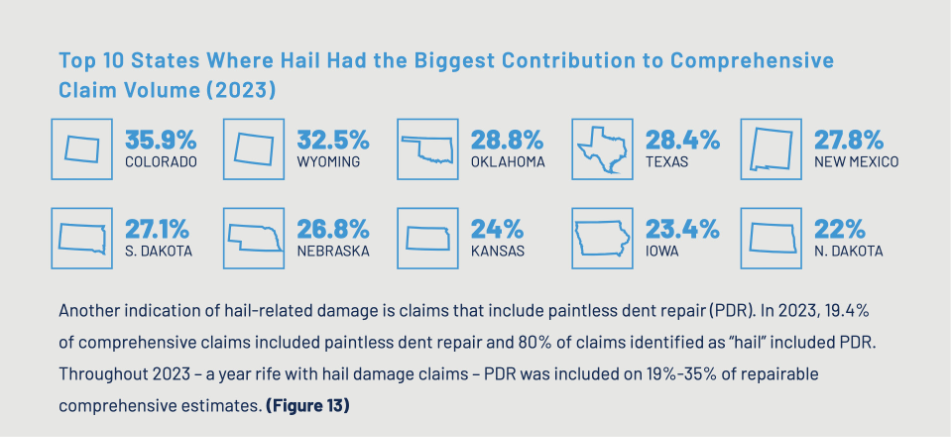The auto insurance and repair industry must “adapt to new patterns and prepare for an unpredictable future,” according to the Crash Course Q2 2024 report released by CCC Intelligent Solutions Inc., a P/C cloud platform provider.
The latest report focuses on how severe weather events — particularly hurricanes and convective storms — are impacting the auto insurance and collision repair industries.

Notably, there have been significant increases in repair times and costs due to storm-related damages.
For example, hail-related auto claims rose to 11.8 percent of all comprehensive claims in 2023, up from 9 percent in 2020, with average repair costs for hail-damaged vehicles increasing by 15 percent over the past three years.
In addition, hail claims are on average 21.7 percent more costly to repair than the average comprehensive claim and 25.6 percent costlier than the average repairable claim.
The report is based on information derived from 300 million claims-related transactions and millions of bodily injury and personal injury protection (PIP) /medical payments (MedPay) casualty claims processed by CCC customers. CCC found that geographic shifts where there has been influx of new residents to hurricane- and hail-prone areas like Florida, Colorado and Texas have intensified the impact on insurers and repair shops, leading to higher volumes of claims and stressing the existing repair infrastructure.
A case study in the report highlights Hurricane Ian’s impact in 2022, where comprehensive estimates tripled in affected states and increased nearly sevenfold in Florida.
The average total cost of repair (TCOR) increased 3.3 percent in Q1 2024 compared to Q1 2023, with labor rates and parts costs contributing to the rise.
Q1 2024 saw significant improvements in repair cycle times, with vehicles entering repair shops six days sooner compared to Q4 2023.
Electric vehicles (EVs) accounted for 2.4 percent of all repairable claims in Q1 2024, up from 1.6 percent in Q1 2023.
The average repair cost for EVs is 46.9 percent higher than for non-EVs, primarily due to higher labor costs. For vehicles 3 years and newer, the average repair cost for EVs is 19.5 percent more than non-EVs.
The report found that casualty and medical costs associated with auto claims continue to rise, with high-dollar procedures experiencing significant inflation.
Additionally, uninsured and underinsured motorist (UM/UIM) injury claims frequency increased by 44 percent, rising from 9.4 percent in Q1 2023 to 13.5 percent in Q1 2024, as households struggle with rising auto insurance premiums.
High turnover among adjusters is hindering subrogation efforts, leading to a 16 percent decrease in referrals.
Carriers are increasingly using technology to streamline subrogation processes and improve recovery rates.
“Extreme weather events are increasing in severity, becoming major disruptors in the auto claims and repair industry,” said Kyle Krumlauf, director of industry analytics at CCC and co-author of Crash Course. “Our Q2 report delivers critical insights, showing that the frequency and severity of storms are not just a seasonal issue but a persistent challenge that demands strategic planning and swift adaptation from industry players.”
Previously published annually, the Crash Course report is being released quarterly in 2024 to provide more frequent updates on key trends and insights. The Q2 2024 report is the 30th edition of Crash Course.





















 What to Expect in 2026: U.S. P/C Results More Like 2024
What to Expect in 2026: U.S. P/C Results More Like 2024  U.S. E&S Outlook No Longer Positive: AM Best
U.S. E&S Outlook No Longer Positive: AM Best  Executives on the Move at HSB, American Modern Insurance Group, AIG
Executives on the Move at HSB, American Modern Insurance Group, AIG  Viewpoint: Mapping Evolving Regulatory Terrain for MGAs, MGUs and Other DUAEs
Viewpoint: Mapping Evolving Regulatory Terrain for MGAs, MGUs and Other DUAEs 




